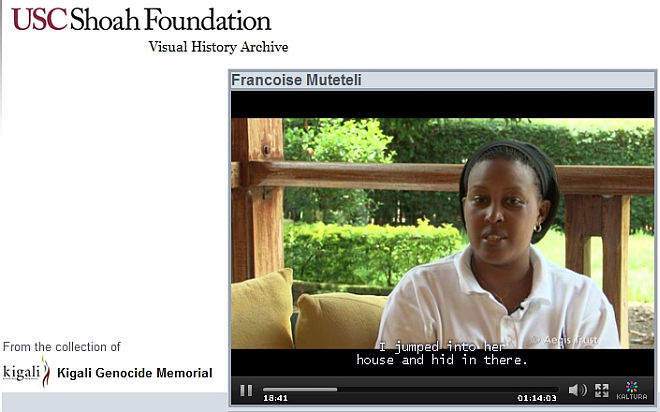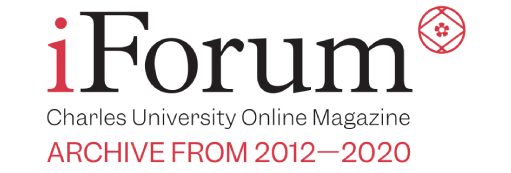Jakub Mlynář (MFF UK) • foto: MFF UK • 22 May 2013
Every Genocide Leaves a Legacy: Rwandan Tutsi Genocide Testimonies Integrated Into USC Shoah Foundation’s Visual History Archive available at Charles University
USC Shoah Foundation – The Institute for Visual History and Education has added a collection of testimonies of survivors and rescuers from the 1994 Rwandan Tutsi genocide to its Visual History Archive. This marks the first integration of testimonies other than Holocaust survivors and witnesses into the Visual History Archive. The 65 audiovisual interviews in this new collection mark the beginning of the Rwanda Archive and Education Program, the Institute’s landmark initiative in partnership with Aegis Trust at the Kigali Genocide Memorial (KGM), that aspires to record and preserve approximately 500 Rwandan testimonies as an educational resource for the entire world, forever.

A screenshot of Visual History Archive’s user interface with the testimony of Francoise Muteteli, who survived the genocide of Tutsi in Rwanda in 1994.
„Every genocide leaves a legacy,” said Freddy Mutanguha, Country Director of Aegis in Rwanda, who lost his parents and four sisters during the genocide. „This legacy includes the memories of survivors. I gave my testimony to the Institute because I think it’s important to preserve historical records of what happened in Rwanda. Through the educational use of testimony, made possible by access to the Visual History Archive, the memories of Rwandan survivors and Holocaust survivors are becoming a conduit for peace in my country, as well as in countries across the world.”
The Rwanda Archive and Education Program is part of an ongoing effort by the Institute to broaden the content in its Visual History Archive. „The Rwandan testimonies will support scholarship and research into the causes and consequences of genocides and the role of audiovisual testimony in research and education, as well as the development of education programs and learning tools for students in Rwanda and worldwide,” said USC Shoah Foundation Executive Director Stephen D. Smith. He also noted that Steven Spielberg established the Institute in 1994 - the same year as the outbreak of genocide in Rwanda.
In addition to Rwandan Tutsi genocide, the Institute is also fundraising to integrate testimonies from the Armenian and Cambodian genocides. Each testimony collection is to add context for the others, providing multiple pathways for students, educators, and scholars to learn from the eyewitnesses of history across time, locations, cultures, and social-political circumstances.
The Institute recorded 15 Rwandan testimonies in the United States, and Aegis, which began working with the Institute in 2008 and has started providing its first 50 testimonies taken in Rwanda. In addition to becoming available in the Visual History Archive that is available at 43 institutions and universities around the world, testimonies will be included in the partnership’s work to establish a national peace-building education program that will eventually be available in the five provinces of Rwanda.
Some of the testimonies will also be added to the Institute’s public web portal, called the Visual History Archive Online (vhaonline.usc.edu). By summer 2013, the testimonies will also be integrated into IWitness, the Institute’s award-winning website for secondary students and teachers (http://iwitness.usc.edu).
How to access the interviews?
Nearly 52 000 testimonies of the Holocaust and Rwandan Tutsi genocide survivors are fully available in the Malach Centre for Visual History in Prague. Six separate computer work-stations are ready in the Library of the Faculty of Mathematics and Physics of Charles University on Malostranské náměstí 25, Praha 1 (Lesser Town Square, Prague 1). Anyone interested from the academy as well as the general public are welcome, you just have to register and create your user account. The user interface is easy to work with, but still sophisticated enough for research purposes. We will gladly assist you during the research work. Visit the Malach CVH during our opening hours (every workday except Monday), contact us via e-mail or find more information on our website.
About the USC Shoah Foundation
USC Shoah Foundation – The Institute for Visual History and Education (sfi.usc.edu) is dedicated to making audio-visual interviews with survivors and other witnesses of the Holocaust and other genocides, and giving a compelling voice for education and action. The USC Shoah Foundation’s current collection of nearly 52,000 eyewitness testimonies contained within its Visual History Archive preserves history as told by the people who lived it. Housed at the University of Southern California, within the Dana and David Dornsife College of Letters, Arts and Sciences, the USC Shoah Foundation works with partners around the world to advance scholarship and research, to provide resources and online tools for educators, and to disseminate the testimonies for educational purposes.
About Aegis Trust
The Aegis Trust is an international organization working to prevent genocide. Aegis honors the memory of the victims of genocide and enables students, professionals, decision-makers and a wider public to meet survivors and learn from their experiences. Through education, Aegis works to build long-term peace and confront the prejudice and beliefs that lead to genocide, while finding ways to support survivors to rebuild their lives. Aegis conducts research on places where genocide is a current threat, works to end impunity by holding perpetrators to account, provides policy advice to decision-makers who can respond, and undertakes advocacy to take the voices of those at risk to politicians, the media and the public. Launched in 2000, Aegis developed from the work of the UK Holocaust Centre and has offices in London, UK and Kigali, Rwanda.
About Kigali Genocide Memorial
In 2001, the Mayor of Kigali and Rwanda’s Minister of Culture travelled to various memorials and museums in Europe and North America. On this trip they discovered The Holocaust Centre in the UK – home of the Aegis Trust. Inspired by The Holocaust Centre’s function as both a place of remembrance and education, they commissioned Aegis to create the Kigali Genocide Memorial. The Memorial was opened in 2004 on the 10th anniversary of the genocide. Standing in the heart of Rwanda’s capital at a site where some 250,000 victims of the genocide are buried, it is comprised of exhibitions, memorial gardens, educational facilities and the Genocide Archive of Rwanda. It hosts tens of thousands of visitors each year, from local Rwandan school students to international dignitaries such as former US President Bill Clinton and UN Secretary-General Ban Ki-Moon. The Memorial serves both as a place of commemoration and as a unique educational centre. On behalf of CNLG, Aegis manages the Kigali Genocide Memorial, ensuring it continues to be a place of commemoration and a place for investment in peace-building. The Memorial operates entirely on the support of generous donors.
